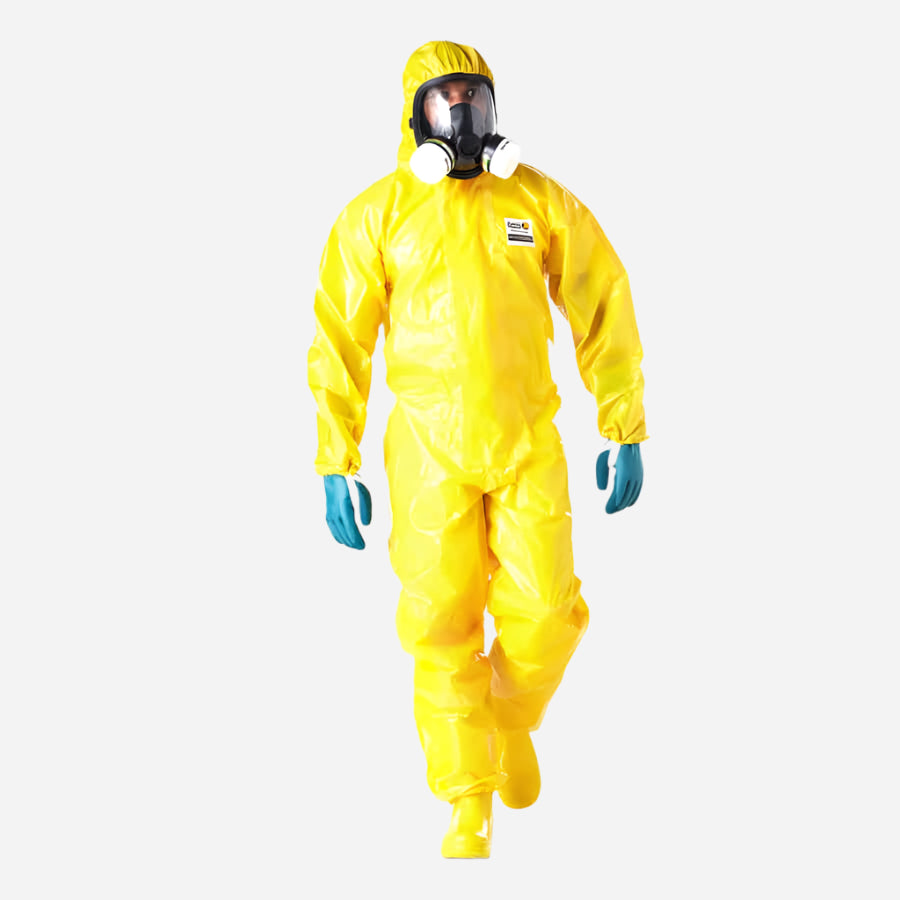SKU:PROMAX C4000
DROMEX PROMAX C4000 DISPOSABLE COVERALL
DROMEX PROMAX C4000 DISPOSABLE COVERALL
Yellow Polypropylene and Polyethylene foil 88g/m²(±2 g/m²)
Type 3, 4, 5 & 6 disposable coverall
Ultrasonic welded & taped seams preventing permeation, dust & liquid ingress
Resistant to penetration by blood/fluids, wet bacterial penetration, biologically contaminated aerosols & powders
Permeation and chemical penetration protection against a basic range of chemicals: Sulphuric Acid: 96% Class 6 (Permeation), Class 3 (Penetration); Sodium Hydroxide 10% Class 3 (Penetration); Xylene – Class 3 (Permeation); 1-Butanol – Class 3 (Penetration)
FEATURES
FEATURES
- Type 3, 4, 5 & 6 disposable coverall
- Yellow polyproplyene and polyethylene foil fabric
- Ultrasonic welded & taped seams preventing permeation, dust & liquid ingress
- Double zip & storm flap for secure front protection
- Double elasticated cuff with thumb loop
- Double layer cushioned knee pads for comfort & durability
- Protects the arms, legs, torso & head from the hazards of light liquid sprays, chemical splashes & sprays, airborne solid particulates, radioactive contamination, anti-static dissipation & infective agents contact
- Resistant to penetration by blood/fluids, wet bacterial penetration, biologically contaminated aerosols & powders
- Permeation and chemical penetration protection against a basic range of chemicals: Sulphuric Acid: 96% Class 6 (Permeation), Class 3 (Penetration); Sodium Hydroxide 10% Class 3 (Penetration); Xylene – Class 3 (Permeation); 1-Butanol – Class 3 (Penetration)
IDEAL APPLICATION
IDEAL APPLICATION
- Agriculture
- Butchery & food processing
- Brewing industry
- Cleaning industry
- Chemical industry
- Healthcare
- Painting
SAFETY CERTIFICATION
SAFETY CERTIFICATION
- Performs with the requirements of CE type examinations, PPE Directive, 89/686/EEC
- EN ISO 13688:2013 Protective clothing – general requirements
- EN 14605:2005 + A1:2009 Protective clothing against liquid chemicals – Performance requirements for clothing with liquid-tight (Type3) or spray tight (Type 4) connections, including items providing protection to parts of the body only (Types PB (3) and PB (4))
- EN 13034:2005 + A1:2009 Protective clothing against liquid chemicals – Performance requirements for chemical protective clothing offering limited protective performance against liquid chemicals
- EN ISO 13982-1:2004 + A1:2010 Protective clothing for use against solid particulates – Part 1: Performance requirements for chemical protective clothing providing protection to the full body against airborne and solid particulates
- EN 1073-2:2002 Protective clothing against radioactive contamination – Requirements and test methods for non-ventilated protective clothing against particulate radioactive contamination
- EN 14126:2003 + AC:2004 Protective clothing – Performance requirements and test methods for protective clothing against infective agents
- EN 1149-5:2008 Protective clothing – Electrostatic properties – Part 5: Material performance and design requirements
UNDERSTANDING WORKWEAR MATERIALS AND STANDARDS
Couldn't load pickup availability

PPE INSIDER
View all-

Choosing the Right Respiratory Protection: Expl...
Welcome to our comprehensive guide on selecting the appropriate mask for your needs. Whether you're involved in painting, construction, healthcare, or any other industry, choosing the right mask is crucial...
Choosing the Right Respiratory Protection: Expl...
Welcome to our comprehensive guide on selecting the appropriate mask for your needs. Whether you're involved in painting, construction, healthcare, or any other industry, choosing the right mask is crucial...
-

EN166 and ANSI Z87.1 Eye Protection Standards: ...
Explore EN166 and ANSI Z87.1 eye protection standards, ensuring impact resistance, optical clarity, and durability for industries like welding, mining, and construction.
EN166 and ANSI Z87.1 Eye Protection Standards: ...
Explore EN166 and ANSI Z87.1 eye protection standards, ensuring impact resistance, optical clarity, and durability for industries like welding, mining, and construction.
-

Choosing the Right Workwear: Materials, Standar...
Explore the different workwear materials like cotton, polycotton, flame retardant, acid-resistant, and more. Learn how to choose the right fabric for safety and durability.
Choosing the Right Workwear: Materials, Standar...
Explore the different workwear materials like cotton, polycotton, flame retardant, acid-resistant, and more. Learn how to choose the right fabric for safety and durability.




